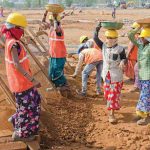 Prof. Raj Kishore Panda* in Bhubaneswar, November 23, 2023: Access to financial services is recognized as an important aspect of development. In keeping line with this argument, the RBI as well as Government of India has implemented a number of schemes over time for accessing financial services in the country.
Prof. Raj Kishore Panda* in Bhubaneswar, November 23, 2023: Access to financial services is recognized as an important aspect of development. In keeping line with this argument, the RBI as well as Government of India has implemented a number of schemes over time for accessing financial services in the country.
However, as available reports suggest a large percentage of country’s population, particularly low-income households, backward communities, landless etc still remain greatly dependent on informal / non-institutional agencies for meeting their credit requirements.
This raises the question as to how does informal credit continue in serving a sizeable section of the population in the country even today in spite of so many initiatives by the government and RBI in widening and deepening institutional credit.
As regards the size of operation of informal credit in the country, the latest All-India Debt and Investment Survey, 2019 conducted by NSSO in its 77th Round has reported that 10.2 percent of indebted households in rural India and 4.9 percent indebted households in urban India have outstanding debt owed to non-institutional credit agencies.
Among the indebted rural households owed to non-institutional sources 10.3 percent belong to cultivating households and 10 percent belong to non-cultivating households. Besides, 7 per cent of rural households are indebted to both institutional and non-institutional credit agencies. This indicates that borrowing from non-institutional agencies persists in the country in a sizeable proportions even if it has been reduced greatly when compared with the situation prevailed in the beginning years of independence.
However, here the question is who borrows from the informal agencies? Studies in this context have amply demonstrated that it is the low-income households, the landless and the vulnerable communities who constitute the predominant sections of the clients of the informal agencies. Studying on the extent of link between poor households and informal credit, Banerjee and Duflo (2007) in case of Hyderabad have documented that 95 percent of all borrowers living below $2/day were found accessing informal sources even when banks are present.
Dasgupta et al (1989) study provides evidence from Delhi that of all the borrowers 70 percent were found getting credit from both formal and informal agencies at the same time. The findings from these and more studies reveal how informal credit continues to remain close to poor and low-income households even when there are reports on the phenomenal growth in the coverage of formal credit in the country and particularly benefiting the low-income households.
 While examining the working of non-institutional credit agencies in the country we come across plenty of literature which largely has denigrated them as exploitative. However, all the sources of informal / non-institutional credit are not exploitative.
While examining the working of non-institutional credit agencies in the country we come across plenty of literature which largely has denigrated them as exploitative. However, all the sources of informal / non-institutional credit are not exploitative.
Generally we find three types of non-institutional credit suppliers prevailing in rural areas viz; transactional credit suppliers (professional money lenders, local landlords and traders) mutual credit suppliers (chit funds, credit societies) and personal credit suppliers (friends and relatives). Loans obtained from relatives and friends largely do not carry interest. It is very much reciprocating with each other.
So also with the credit obtained from chit funds and credit societies which happen to be a give and take process. Only credit obtained from professional moneylenders, land lords, pawn-brokers and traders who do credit as a business transaction may be considered exploitative as it carries higher interest rate with certain terms and conditions. Even in the context of interest rates charged the credit advanced by informal agencies, some empirical studies have shown that despite high interest rates on an annual basis, actual interest payment burden is worked out to be low since loan size is small and repaid in a very short time period.
Under the above situation where formal credit market seems under-penetrative and informal credit market remains un-recognized what is very much needed is interlinking both the sectors of credit in the country. In recent years, no doubt the government’s approach towards non-institutional sources of credit has changed considerably. In contrast to the earlier approach to curb the activities of informal credit, there has been gradual shift in attitude from negative to positive which can be seen in the form of integrating the formal and informal credit sectors.
As a first step in this direction the government has made several efforts to formalize the economy. Introduction of GST, digital payment systems and enrollment of informal sector workers on e-Shram have been initiated to encourage formalization of the economy. However there is need for a major reform in the financial sector- to integrate both formal and informal financial markets.
 In India a large majority of workers (about 91 percent) are working in the informal – unorganized sector. These workers have very limited access to formal credit owing to lack of marketable assets as collaterals, low income and want of a steady employment. For them informal credit market is seen as a viable choice to obtain a loan. Besides, as studies reveal hardly 14 percent of enterprises in the MSME sector get access to formal credit. Others depend on informal sources for their working capital and other day to day needs.
In India a large majority of workers (about 91 percent) are working in the informal – unorganized sector. These workers have very limited access to formal credit owing to lack of marketable assets as collaterals, low income and want of a steady employment. For them informal credit market is seen as a viable choice to obtain a loan. Besides, as studies reveal hardly 14 percent of enterprises in the MSME sector get access to formal credit. Others depend on informal sources for their working capital and other day to day needs.
On the basis of the above discussion it may be concluded that in a country like India suffering from under-penetrative formal credit market but having the presence of a very large informal credit market, there arises a strong argument for integrating the two sectors so as to intensify the volume of credit transactions in the country. The availability of higher volume of credit will accelerate the pace of economic growth in the country.
*[Formerly, Professor of Economics, Utkal University and Director, Nabakrushna Choudhury Centre for Development Studies, Bhubaneswar.]


Leave a Reply
Be the First to Comment!